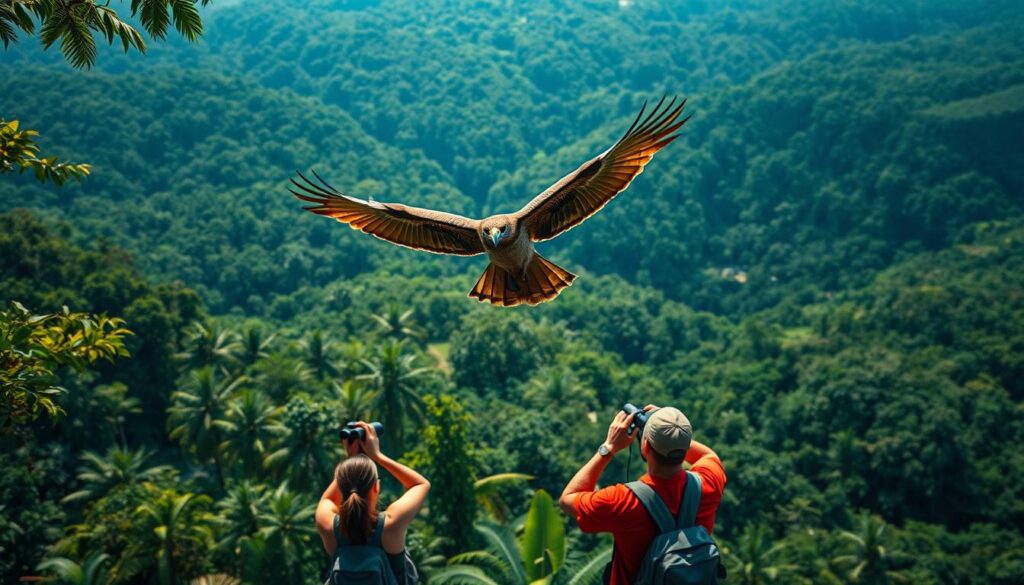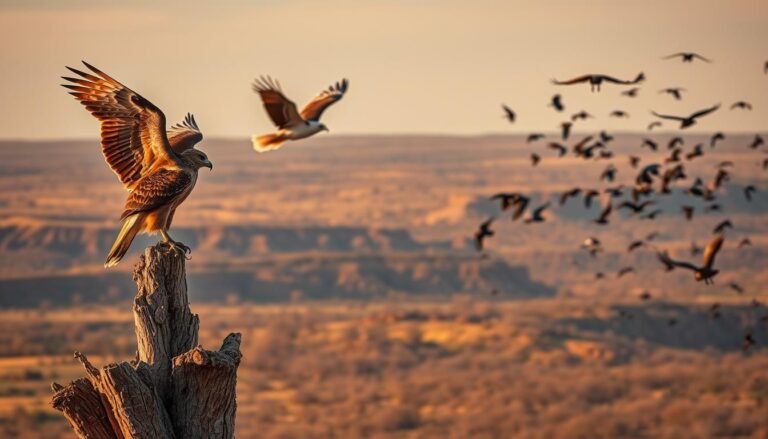Birds of Prey Costa Rica: Exploring Costa Rica’s biodiversity, the birds of prey stand out to me. This area is home to hawks, eagles, falcons, and owls. The rainforests here are important homes for these awesome birds. Costa Rica has 10 types of raptors that play key roles in nature.
The Swallow-tailed Kite lives in southern Costa Rica all year. Other places see it mainly when it’s wet. The Gray Hawk does well across Costa Rica, even where humans live. Lowland areas are where you’ll see the Roadside Hawk often. Birding trips often spot the Short-tailed Hawk and the Common Black-Hawk in coastal spots, making my experiences richer.
Raptors in Costa Rica range from the Red-tailed Hawk to various owls. They make the area prime for those who love birds and nature. I want to show you their living places, actions, and how we can save them. It’s crucial for Costa Rica’s stunning wildlife.
Birds of Prey Costa Rica : Key Takeaways
- Costa Rica is home to 10 commonly seen raptor species, making it a prime location for birdwatching.
- The Swallow-tailed Kite is prevalent year-round in southern Costa Rica and a wet season visitor elsewhere.
- The Gray Hawk adapts well to human-altered habitats and is widely observed in the Central Valley.
- Common Black-Hawks are abundant along coastal areas, especially in mangroves and coastal forests.
- Birdwatchers can frequently spot the Short-tailed Hawk during excursions, as it is commonly sighted daily.
Introduction to Birds of Prey in Costa Rica
Costa Rica is home to over 900 bird species, making it a rich place for wildlife. Raptors are key birds in this ecosystem, thanks to their sharp claws, hooked beaks, and amazing eyesight. They are top hunters, keeping nature in balance.
Overview of Raptors
Raptors, or birds of prey, include hawks, eagles, and owls. They have special skills for hunting, thriving in Costa Rica’s wild landscapes. Birds like the Harpy Eagle and the Black Hawk-Eagle are crucial for healthy environments. They keep smaller animal numbers in check.
Importance of Birds of Prey
Birds of prey do more than hunt; they show how healthy an ecosystem is. By managing prey levels, raptors boost biodiversity and keep habitats balanced. As apex predators, they’re key to the survival of various species in Costa Rica.
Conservation Status
Many raptors are in danger due to losing their homes and climate change. Protecting these birds is vital, and conservation work is ongoing. NGOs and local governments are fighting to save them. Knowing about their plight helps us understand why we need to protect their homes.
| Raptor Species | Conservation Status | Habitat |
|---|---|---|
| Harpy Eagle | Near Threatened | Tropical Rainforests |
| Black Hawk-Eagle | Least Concern | Lowland Forests |
| Great Horned Owl | Least Concern | Various Habitats |
Common Species of Birds of Prey
Costa Rica is a wonderland for birds of prey, with each bird displaying its own special traits. The Harpy Eagle, Black Hawk-Eagle, and Great Horned Owl stand out in the skies above. These birds highlight the amazing variety of wild creatures found in Costa Rica.
Harpy Eagle
The Harpy Eagle is at the top of the food chain in tropical rainforests. It’s known for its impressive size and powerful presence. It has a wingspan of up to 7 feet and it mainly hunts monkeys and sloths. Whenever people spot these magnificent eagles costa rica, they’re usually amazed.
Black Hawk-Eagle
The Black Hawk-Eagle is a common sight along the Tarcoles River, hunting for small creatures. It has a special way of hunting and eats crabs, reptiles, and small fish. I noticed a lot of young Black Hawk-Eagles, which means they’re having lots of babies. Their ability to adapt and varied diet highlight how tough hawks costa rica are.
Great Horned Owl
The Great Horned Owl is a master of night hunting, thanks to its amazing adaptations. It’s known for its distinctive tufted ears and strong claws. It eats small mammals and birds, showing it’s an important part of the food web. Watching these owls costa rica was fascinating, especially their silent flight and sharp senses.
| Species | Habitat | Diet | Unique Feature |
|---|---|---|---|
| Harpy Eagle | Tropical Rainforest | Monkeys, Sloths | Large wingspan (up to 7 feet) |
| Black Hawk-Eagle | Tarcoles River | Crabs, Reptiles, Small Fish | Successful juvenile population |
| Great Horned Owl | Woodlands, Urban Areas | Small Mammals, Birds | Recognizable tufted ears |
Habitats of Costa Rica’s Raptors
Costa Rica is home to a variety of raptors, each adapted to live in diverse habitats. From rainforests to beaches, these environments shape their way of life. Knowing about these habitats helps us appreciate Costa Rica’s wildlife even more.
Tropical Rainforests
The dense jungles offer shelter and food for many raptors. Here, they find plenty of prey, thanks to the forest’s biodiversity. For example, the Harpy Eagle thrives in these areas.
These forests give them perfect spots to hide and hunt from. The layered forest structure aids their stealth attacks.
Mountainous Regions
Costa Rica’s mountains provide unique homes for different raptors. The varying terrains and climates create special wildlife interactions. Raptors, like the Crested Caracara, adapt their hunting to this rugged environment.
These areas are key for their survival. They learn to hunt effectively here.
Coastal Areas
The coasts offer rich ecosystems for raptors, such as the Osprey. These birds hunt fish and adapt to the water-rich habitats.
The abundance of food here attracts many species. This highlights the need to protect these coastal regions for conservation.
Behavior and Hunting Techniques
Learning about the behavior and hunting techniques of raptors opens a window to the exciting world of Costa Rica’s birds of prey. These incredible birds use different methods to catch their food, which is key to their survival. They can fly high or dive quickly, showing their amazing ability to adapt and their skill.
Hunting Strategies
The Double-toothed Kite and Swallow-tailed Kite are examples of raptors with varied hunting methods. These methods are shaped by their life in the wild. Some key techniques include:
- Soaring: Many birds of prey use warm air currents to glide easily while looking for prey on the ground.
- Diving: The Peregrine Falcon, known for its incredible speed, dives sharply to catch birds in mid-air.
- Social feeding: Swallow-tailed Kites sometimes hunt in groups to catch insects or small reptiles together.
Nesting Habits
Nesting is crucial for raptor chicks to survive. The Double-toothed Kite nests in trees or cliffs for their young’s safety and ease of access. Let’s look at their nesting habits:
| Species | Nest Location | Eggs Laid | Incubation Period |
|---|---|---|---|
| Double-toothed Kite | Trees or cliffs | 1-2 | 42-45 days |
| Swallow-tailed Kite | Tall trees | 2-3 | 28-30 days |
Social Structures
The way birds of prey interact varies greatly. For example, the Swallow-tailed Kite shows complex behaviors in groups. These include:
- Solitary hunting: Many raptors prefer hunting on their own, focusing on stealth and observation.
- Flock hunting: Some birds migrate and hunt in large groups to find food more efficiently.
- Territorial displays: During mating season, they may show off and make sounds to claim their area.
Importance in Ecosystems
In Costa Rica, birds of prey are crucial for ecosystems. They balance species numbers and boost biodiversity. By controlling prey populations, these raptors keep the environment healthy. This is vital for the well-being of Costa Rica’s wildlife.
Role as Predators
Raptors like the Harpy Eagle and Peregrine Falcon are key predators. They have sharp eyesight and great hunting skills. This stops smaller species from becoming too numerous, which could harm ecosystems. Birds of prey are essential for ecological balance.
Impact on Biodiversity
Raptors have a big impact on biodiversity. They prey on the weak or sick, helping the health of many species. With 74 species of raptors, they enrich Costa Rica’s ecosystems considerably.
Natural Pest Control
Birds of prey also control pests naturally. They hunt rodents and small mammals, protecting crops and preventing disease. This helps not only wildlife in Costa Rica but also supports sustainable farming. Such practices benefit local communities and economies.
| Species | Average Observations per Season |
|---|---|
| Mississippi Kites | 112,145.4 |
| Turkey Vultures | 936,548 |
| Swallow-tailed Kites | 3,000 |
| Peregrine Falcons | 747,772.6 |
| Broad-winged Hawks | 474.6 |
| Black Vultures | 14.8 |
| Sharp-shinned Hawks | 324,805 |
| Swainson’s Hawks | 13 |
Conservation Efforts

In Costa Rica, many initiatives protect raptors and their homes. These efforts keep ecosystems balanced and help wildlife thrive.
Protected Areas and Reserves
Protected areas are crucial for birds of prey in Costa Rica. The Kéköldi Raptor Migration Count Site is very important. It counts over 1,000 raptors daily. Recognized as the second biggest hawkwatch in the Americas, it shows why we must protect these places for the future.
Breeding Programs
Breeding programs help save local raptors. Working with groups like the Peregrine Fund, they focus on saving habitats and research. This has helped the Costa Rican Pygmy-owl, which is doing well because of these efforts and special breeding programs.
Community Involvement
Getting the community involved is key to conservation. It encourages people to live in ways that are good for both animals and humans. Teaching locals about the value of birds of prey builds respect for nature and motivates them to help protect Costa Rica’s raptor diversity.
Birdwatching Opportunities
Going birdwatching in Costa Rica lets you see different places full of raptors and wildlife. This country has many famous spots for bird sightings, offering unique environments. I’ve found several top spots filled with different bird species.
Best Locations for Sightings
Some places in Costa Rica are especially great for birdwatching because of their unique features:
- La Selva Biological Station: This area covers about 2,500 acres and is home to over 420 bird species. It has plenty of untouched forest.
- Monteverde Cloud Forest: It houses more than 400 bird species in its lush, cloud-covered areas.
- Cerro de la Muerte: It’s an excellent place for seeing migratory birds, particularly during the raptor migration.
- Tortuguero National Park: Known for its variety of birds all year round, it gave me unique birdwatching moments.
- Corcovado National Park: Famous for its biodiversity, it’s a prime spot to see rare and endangered birds.
Tips for Birdwatchers
Here are some tips to get the most out of birdwatching in Costa Rica:
- Buy good binoculars to see birds from far away clearly.
- Join local birdwatching tours in Costa Rica for expert help and more knowledge.
- Wear clothes that blend with nature to not scare off the birds.
- Stay patient and quiet; sometimes you see more birds this way.
- Carry a field guide to identify the birds you see.
Ideal Seasons for Viewing
The right timing is key for birdwatching. The best months to see raptors and other birds are during these seasons:
| Season | Best for | Notable Species |
|---|---|---|
| Green Season (May to October) | Breeding and migration | Resplendent Quetzal, Harpy Eagle |
| Dry Season (November to April) | Active birding and good sightings | Scarlet Macaw, Short-tailed Hawk |
| Raptor Migration (September 21 – October 3) | Seeing various raptors | Turkey Vultures, Peregrine Falcons |
Cultural Significance
In Costa Rica, birds of prey are more than just wild animals. They hold deep cultural importance. Their stories are part of local folklore, showing how wildlife and people are connected. These birds symbolize freedom, strength, and the will to survive.
Birds of Prey in Local Folklore
Birds of prey play big roles in Costa Rican legends. They mirror human qualities like courage and resilience. Many tales show them overcoming obstacles, symbolizing victory against challenges. This has made them key figures in local art and stories.
Symbols in Art and Literature
The impact of these birds stretches into art and literature in Costa Rica. Artists paint and sculpt them in flight, celebrating their royal nature and bond with the environment. Writers see them as protectors of the forests, crafting stories that urge us to take care of nature. Events like Raptor Fest bring people together to honor and protect these amazing birds.
| Aspect | Description |
|---|---|
| Folklore | Birds of prey as symbols of strength and resilience in local narratives. |
| Art | Depictions of raptors in paintings and sculptures reflecting their majesty. |
| Literature | Raptors as vital characters illustrating themes of freedom and conservation. |
| Festivals | Community gatherings like Raptor Fest celebrating the cultural connection to wildlife. |
Conclusion
Looking to the future, birds of prey in Costa Rica face many challenges. Habitat loss, climate change, and humans pose big threats. Still, with more effort in conservation, we can help these amazing birds. The Peregrine Falcon’s comeback shows us what can happen when we all work together. Seeing more of these falcons is a reminder to keep supporting raptor conservation.
The Future of Birds of Prey in Costa Rica
We need both people and communities to protect these raptors for the future. We’ve seen some wins, like the yellow-headed caracara spreading out. But we can’t ignore species we don’t see much, like the Orange-breasted Falcon. Exploring less known areas could reveal new bird populations. Doing our part and backing conservation will ensure these birds keep flying high.
Final Thoughts on Conservation
I’m really passionate about saving Costa Rica’s birds. We all can help by learning more and getting involved. By spreading the word on how important their homes are, we make a brighter future for them. Together, we can make sure future generations will marvel at these birds, gliding through Costa Rica’s forests.
FAQ
What are the main species of birds of prey found in Costa Rica?
Why are birds of prey important to ecosystems?
What are the primary threats facing raptors in Costa Rica?
How can I enjoy birdwatching for raptors in Costa Rica?
What conservation efforts are underway to protect raptors in Costa Rica?
How do cultural beliefs influence the perception of birds of prey in Costa Rica?
What unique adaptations do raptors have for hunting?
References
| Source Name | URL |
| International Association for Falconry and Conservation of Birds of Prey (IAF) | https://conservationportal.sycl.net/1/falconry-and-conservation |
| Raptor Research Foundation (RRF) | https://raptorresearchfoundation.org/about/ |
| Bird of Prey – Wikipedia | https://en.wikipedia.org/wiki/Bird_of_prey |
| Hawk Mountain Sanctuary | https://www.hawkmountain.org/about/community/our-global-partners |
| Bird of Prey Project | https://birdofpreyproject.org/about-us/ |







